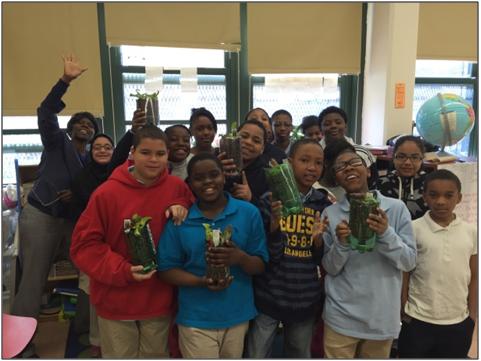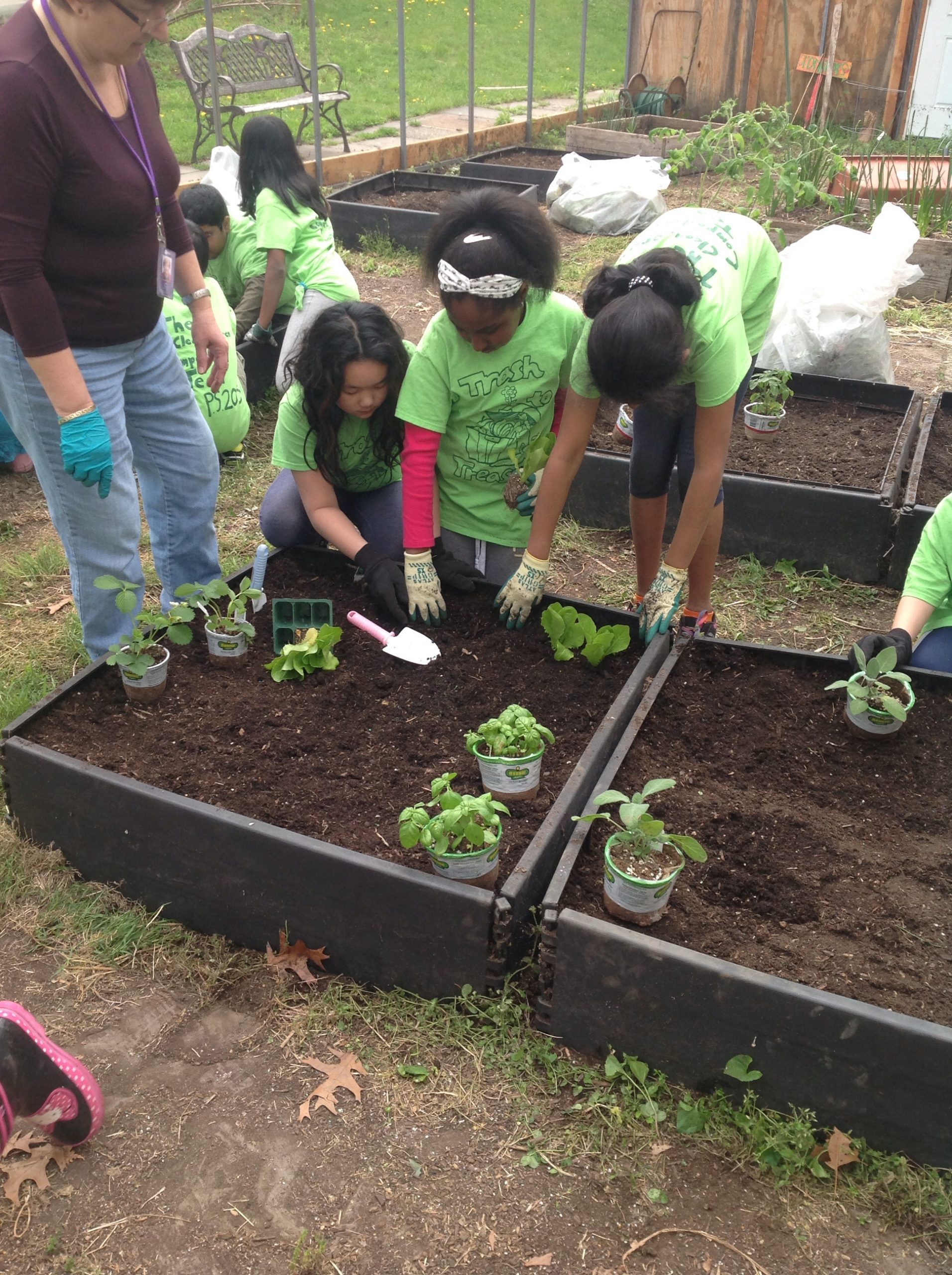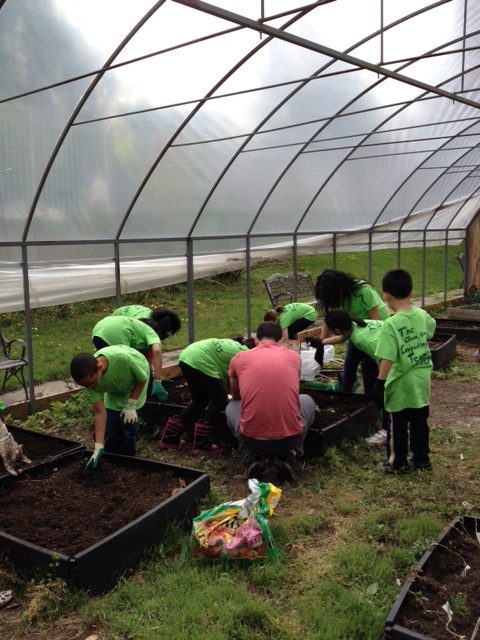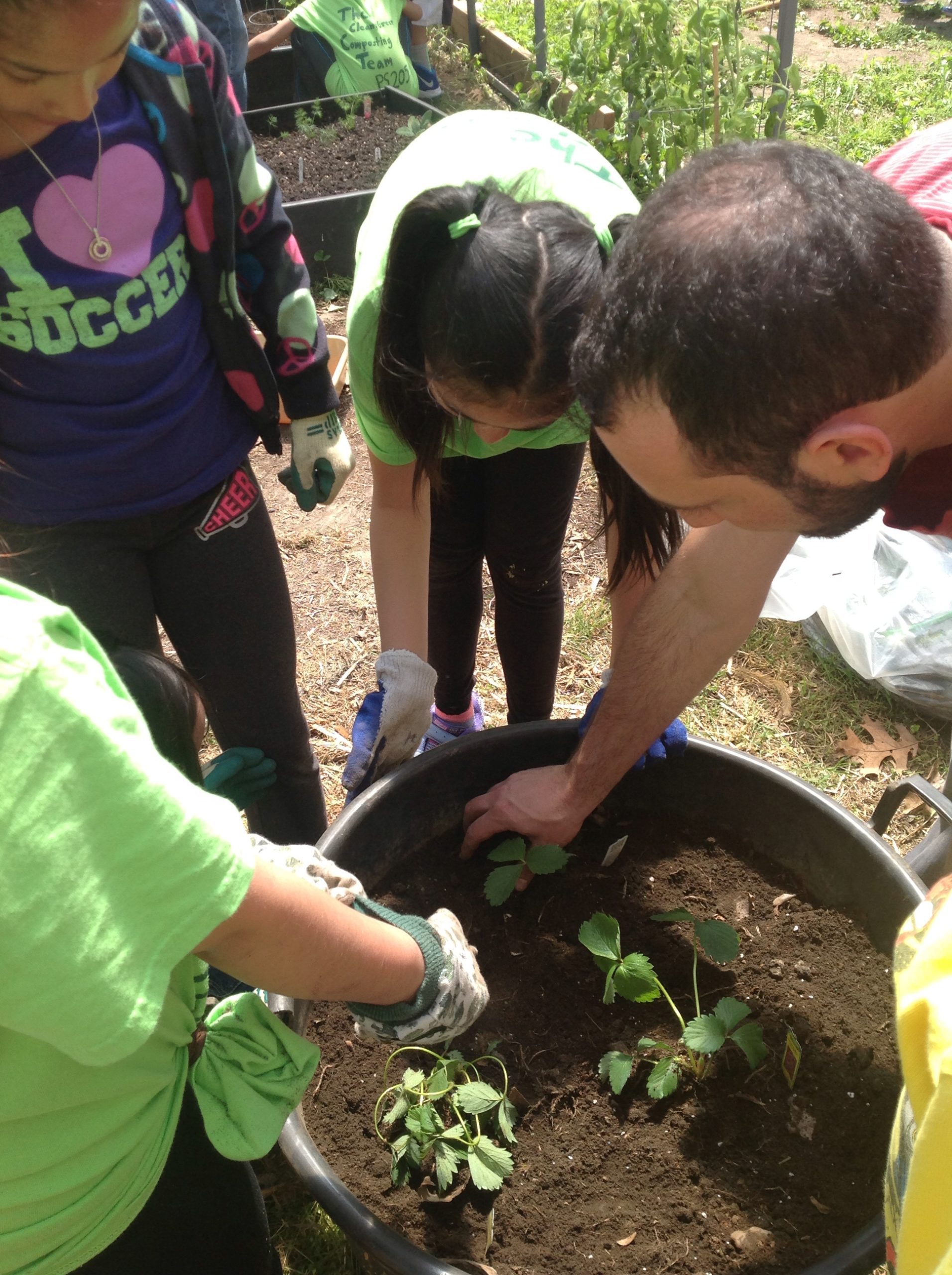Last updated 1/8/18
A New Monarch Butterfly Garden Earth Day Celebration at PS 18Q, 2017
 On April 22nd, 2017, with the help of parents and the PTA, Ms. Young held an amazing Earth Day Celebration with her colleagues, funders, and the Into the Woods team, to plant the two gardens and launch the outdoor classroom. Ms. Young and Ms. Kay organized the event with over students and their parents who helped with the work. The team helped the students and teachers build the edible garden structures and plant the vegetables, as well as turn the soil, clean the ground, and plant native species at the pollinator garden site. The NYC Parks Department also provided numerous native plants. Pamela noted “We were also introduced to the Greenbelt Native Plant Center in Staten Island. This is a resource that most schools are not aware of.” Ms. Young and Ms. Kay have been using the learning garden every day during the growing season since it was established, and have big plans for other green areas surrounding their school in partnership with the NYC Parks Department. Sponsors helped create a video of the event, available for viewing above. This service learning project spearheaded by Pamela Young and her co-teacher Ms. Kay engaged an entire school community, multiple NYC institutions, and global connections.
On April 22nd, 2017, with the help of parents and the PTA, Ms. Young held an amazing Earth Day Celebration with her colleagues, funders, and the Into the Woods team, to plant the two gardens and launch the outdoor classroom. Ms. Young and Ms. Kay organized the event with over students and their parents who helped with the work. The team helped the students and teachers build the edible garden structures and plant the vegetables, as well as turn the soil, clean the ground, and plant native species at the pollinator garden site. The NYC Parks Department also provided numerous native plants. Pamela noted “We were also introduced to the Greenbelt Native Plant Center in Staten Island. This is a resource that most schools are not aware of.” Ms. Young and Ms. Kay have been using the learning garden every day during the growing season since it was established, and have big plans for other green areas surrounding their school in partnership with the NYC Parks Department. Sponsors helped create a video of the event, available for viewing above. This service learning project spearheaded by Pamela Young and her co-teacher Ms. Kay engaged an entire school community, multiple NYC institutions, and global connections.
Partners in Service Learning
The NYU Wallerstein Collaborative for Urban Environmental Education supports teachers from the Into the Woods program to implement Service Learning with their classes.
Service Learning is a “teaching and learning strategy that integrates meaningful community service with instruction and reflection to enrich the learning experience, teach civic responsibility, and strengthen communities¹.” Environmental service learning considers ecosystems as integral parts of the communities it serves.
In addition, the NYU Wallerstein Collaborative offers professional development and programming to promote environmental literacy, outdoor experiences, and hands-on learning in NYC. Learn more about our environmental education at www.nyu.edu/wallerstein.
Rally for the Future at Rockaway Beach with PS 43, 2017
Ms. Scavone and her 5th grade class organized the Rally for the Future at Rockaway Beach which took place on May 22, 2017. For this event, the students invited other classes from their school (PS 43) as well as other local schools, including other ITW teachers and their classes. Working in collaboration with the Rockaway Waterfront Alliance and Surfrider Org. they organized and led the day’s activities which included a beach clean-up and an art-making session with plastic trash. All of the attending students had signs with messages for the community and a select group made speeches with themes including keeping the beach clean, the effects of plastic pollution, and the importance of the coastal ecosystem and need for its protection. At the rally, a representative of the community’s NYC council made a speech, along with representatives from partnering organizations including Dr. Mary Leou who represented NYU and the Into the Woods team. Ms. Scavone’s students have taken ownership of their beachfront community and continue to evolve as leaders in their community.
More from PS 43Q:
Art Inspired by the Students of Christine Scavone for the Need to Work Together and Protect the Earth!
The Rally for the Future at Rockaway Beach is part of a project by Ms. Scavone and her classes of fifth grade students that have been working together for two years to clean up local beaches. The classes has been focusing on the plastisphere, a vast swarm of plastic waste floating in the waters and washing up on beaches around the world that is harming animals, ecosystems, and people. Through art and composition, coreography, performance, and the professional filming of an original song and dance video; as well as a gigantic piece of art recycled from a conglomeration of garbage on Rockaway beach, the students have a statement to say to the world: pollution is harming animals, humans, and the ocean; we need to work together to protect the earth that we all depend on.
 Tidal Connections – Horseshoe Crabs in Plumb Beach with Classes from PS 48Q, Jamaica Queens
Tidal Connections – Horseshoe Crabs in Plumb Beach with Classes from PS 48Q, Jamaica Queens
Students of three classes from PS 48Q including Into the Woods teacher Ms. Whichard’s 5th grade class extended their classroom studies of coastal ecology out to Jamaica Bay to particiapte in a combined citizen science and service learning program to protect and monitor horseshoe crabs. The focus of their study was the relationship between shorebirds and horseshoe crabs. Two additional teachers joined in using Plumb Beach as an extension of their classroom.
The program was led and administered by the NYU Wallerstein Collaborative and NYC Audubon called Tidal Connections. The classes were introduced to the particular habitat of Plumb Beach and the Gateway National Recreation Area by NYU Wallerstein staff that visited their school. The classes were then taken on a field trip to Plumb Beach during the horseshoe crab mating season where they met with NYC Audubon scientists to receive first-hand insight into the importance of horseshoe crabs and their relationship with shore birds. Students collected data and made observations about horse shoe crabs, shore birds, and coastal habitat.
The day culminated with a beach cleanup in which the students were able to pick up large amounts of plastic and metal trash. The students created posters and conservation messages that they posted in their school and shared with the larger community. This project will continue on an annual basis and is growing with two additional classes from PS 48Q planned to join in in the next year.


TPlanting Milkweed for Monarchs idal Connections – Horseshoe Crabs in Plumb Beach with Classes from PS 48Q, Jamaica QuePlanting Milkweed for Monarchs
by Sam Adel, 4/19/15
Laura Pagano’s service learning project grew out of a conversation she had during an “Into the Woods” workshop. Teachers were discussing Monarch butterflies and their reliance on milkweed—certainly a Monarch’s favorite plant. They lay their eggs exclusively on milkweed plants and their newly hatched larvae (caterpillars) rely on the plant as their sole food source. Given their importance to the life of every monarch, and their survival as a species, Laura and her class planted milkweed as a service learning project to help these beautiful and mysterious creatures.
Ms. Pagano’s science cluster class decided to try their hand at propagating milkweed plants in their classroom. To do this, students researched different ways to germinate milkweed. Milkweed is not the easiest plant to from seed because it relies on a process called cold stratification. In nature, milkweed seeds are dispersed on the wind and then use the winter freeze and thaw cycle to anchor themselves by breaking down into the soil just enough to germinate. Students experimented with three planting methods: 1) sowing seeds directly on the ground in winter, 2) sowing seeds in outdoor pots in winter, and 3) refrigerating the seeds first for several weeks before outdoor planting. The jury is still out on which methodology works the best. The NYU Wallerstein Collaborative for Urban Environmental Education came to help with the planting. Ms. Pagano now offers milkweed seedlings free of charge to other teachers who would like to grow milkweed!
Garden Greens Grow in Brooklyn – From Recycled Soda Bottles

Cassandra Laugen’s 4th Grade Class Project
12/12/14



Ms. Cassandra Laugen did not have to look far to find a great service learning project for her students. Her school, P.S. 205 in Bayside Queens, already had a school courtyard with an over-grown garden and greenhouse, although it had fallen into disrepair. Ms. Laugen set out to develop the greenhouse, or “high tunnel,” into a productive garden complete with compost bins. Upon request, educators from NYU’s Wallerstein Collaborative for Urban Environmental Education met with Ms. Laugen to layout a garden plan and to work with her students to begin planting.
It was a warm April day when NYU staff and Ms. Laugen’s 4th graders ventured out of the classroom and into the garden. The first step required weeding, cleaning, and preparing the garden beds which were out of order. Students worked in groups on the different planting beds. They learned about invasive plants and aromatic plants as they pulled them out. Each group of students added fresh soil and planted tomatoes, basil, peas, and more. Ms. Laugen and parents helped maintain the garden over summer. As a result, there was an excellent harvest of free, healthy, tomatoes, peas, and herbs for the school community.
 A follow-up garden day was held the following October to plant winter crops as an experiment to determine whether the high tunnel could support a winter growing season. Students investigated the difference in air temperature inside and outside the high tunnel and found no difference. Students investigated the growing requirements of various crops and chose to plant radishes, turnips, carrots, beans, and parsley. Compost from the previous spring, made from the cafeteria’s organic waste, was mixed into the garden beds to fertilize the crops.
A follow-up garden day was held the following October to plant winter crops as an experiment to determine whether the high tunnel could support a winter growing season. Students investigated the difference in air temperature inside and outside the high tunnel and found no difference. Students investigated the growing requirements of various crops and chose to plant radishes, turnips, carrots, beans, and parsley. Compost from the previous spring, made from the cafeteria’s organic waste, was mixed into the garden beds to fertilize the crops.
Gardens require constant maintenance throughout the year. To do this, Ms. Laugen receives support from parents, the administration, and custodial staff. The grown-over courtyard and high tunnel at PS 205 is growing once again. Ms. Laugen’s gardening has already paid multiple dividends—in service learning and fresh local produce!





 Tidal Connections – Horseshoe Crabs in Plumb Beach with Classes from PS 48Q, Jamaica Queens
Tidal Connections – Horseshoe Crabs in Plumb Beach with Classes from PS 48Q, Jamaica Queens